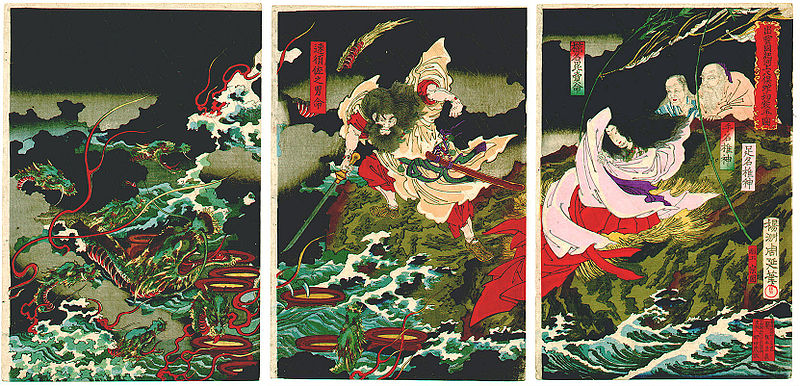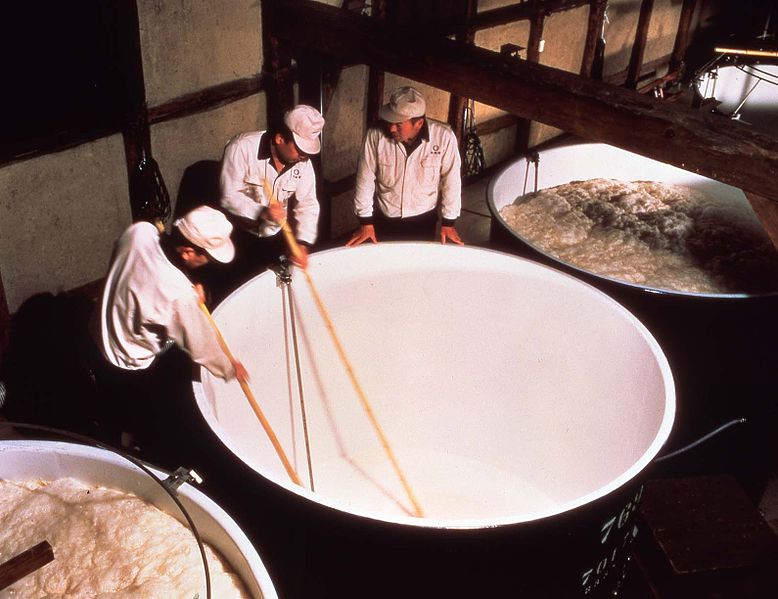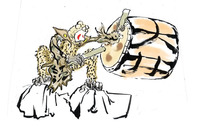Part 12: Mythology Dissection 1
I'm glad everyone liked the Orochi fight! It is a pretty awesome sequence, and yes, Susano is the best.
The Legend of Orochi
Here we go, folks: the big one! Time to talk about “The Legend of Orochi,” and finish up with Susano and Kushi.

Susano
Recap, Susanoo, the god of the sea and storms, had been banished to the underworld after a falling-out with his sister, Amaterasu (and for various other shenanigans). On the way to Yomi, he passed through the mortal realm, where he encountered an old couple, grieving and obviously distressed. Susanoo stopped to ask them what was wrong. The old couple told him that their village was being ravaged by the dread monster Yamato-no-Orochi (meaning eight-forked serpent), a gigantic serpent with eight heads, each more deadly than the last. Every year, the monster would demand a sacrifice from the villagers to sate his hunger; refusal meant the utter destruction of the village! The old couple’s only child, the fair maiden Kushinada-hime was to be the next victim.
Susanoo offered to help the old couple, and the village, by slaying the beast. His motives were not entirely altruistic. When he looked upon Kushinada, he was quite taken with her. As payment for his assistance, he asked for her hand in marriage. The old couple agreed. Considering they were about to lose their daughter anyway, it wasn’t a bad deal.
Kushi
Kushinada-hime was the daughter of the vilage sake brewer. When her parents accepted Susanoo’s proposal, the god turned her into a comb, decorated with a single flower, and put her in his pocket. In the game, Kushi’s hair is styled in the shape of a comb, and some of her concept art shows her with a comb in her hair.
Orochi
Susanoo hatched a plan to deal with the dread serpent. He had the villagers erect a series of gates around the village square. On the other side of each gate, he placed a barrel, filled to the brim with the sake-brewer’s finest sake. Later that evening, Yamato-no-Orochi came into the valley to collect his sacrifice. Susanoo, waiting in the shadows, danced, creating a wind that wafted the scent of the sake towards the serpent. Drawn by the scent, Orochi stuck one of his heads through the gate. Sensing no danger, and wanting a taste of the tantalizing brew, Orochi followed suit with the rest of his heads, plunging his maws into the sake barrels, drinking greedily.
It was at that moment that the trap was sprung. The villagers tripped the catch on the gates, which closed, trapping the beast’s heads. They would not hold for long, of course, for Orochi was immensely powerful. However, his reflexes were slowed by the sake, and the gates served as a sufficient distraction. Susanoo sprung into action. He drew his sword and ran from gate to gate, lopping off the serpent’s heads one by one. When he was done, the body of Orochi lay in the middle of the village, his acrid blood pooling onto the ground.
The villagers praised Susanoo as their savior and showered him with gifts. As the god examined the monster’s body, he noticed the hilt of what looked like a fine sword protruding from its back. Perhaps it was all that was left of some ill-fated adventurer who had attempted to deal with the beast? Susanoo pulled the blade from Orochi’s corpse. It turned out to be a very fine blade indeed! He dubbed the sword Kusanagi-no-Tsurugi, meaning “Grass-Cutting Sword.” He would later present the sword to his sister, as an apology and gesture of peace. Susanoo went on to serve as the god of the underworld, Yomi, alongside his bride, Kushinada.

Susanoo battling Orochi.
Now, something that jumps out at me is that this story is extremely similar to the legend of Saint George and the Dragon. Village ravaged by monster? Check. Beautiful maiden offered as next sacrifice to sate monster’s hunger? Check. Hero appears, slays the monster, and marries said beautiful maiden? Check, check, and check.
It’s an archetypical story; I know there are many other versions of it in western literature and in other cultures as well! For example, there are similar legends in both Greek and Norse mythology, not to mention contemporary literature. It’s old as the hills.
Orochi’s heads:
Each of Orochi’s heads is imbued with a different element, and uses that element to attack. Most of these attacks can be countered with the appropriate Brush Technique.
Fire -breathes fire. Counter with Galestorm.
Water- floods arena. Get to solid ground and Power Slash the head.
Earth- bashes head into ground, causing a shockwave. Power Slash or attack the head while it’s stunned from the impact.
Wind- creates tornadoes. Dissipate them with Galestorm.
Light- shoots lasers. Dodge.
Darkness- emits a cloud of darkness, which temporarily disables the Celestial Brush. Bloom the buds he drops before they open and release the fog.
Lightning- hurls lightning bolts. Dodge.
Poison- spews a toxic cloud. Blow away the cloud with Galestorm.
The symbols on Orochi’s heads, correspond to their element. Fire (火), darkness (闇), lightning (雷), earth (土), light (光), water (水), wind (風), and poison (毒).
The symbols that appear when Susano goes to town on Orochi, do not have anything to do with their element, as Pinechild pointed out. Instead, here's what they mean:
Earth: 命 (fate/life)
Poison: 活 (to live)
Lightning: 回 (turn/return)
Light: 流 (to flow)
Wind: 復 (restore)
Water: 永 (eternal)
Dark: 存 (to believe/exist)
Fire: 衝天七生 ('seven spirited lives,' which is the name of a track from the soundtrack)
The fire head seems to be the leader, as it is the only one that speaks.
Crimson Helm
Crimson Helm looks exactly the same as Orochi’s fire head, right down to the helmet. Significance? Well, since Orochi’s shadow emerges from Crimson Helm’s corpse, perhaps Crimson Helm was nothing more than a puppet, controlled by Orochi himself!
Sake

Sake barrels
Sake is an alcoholic drink made from rice. Its alcohol content is higher than that of wine or beer, but sometimes it is diluted to reduce its potency a bit. Before brewing, the rice is polished to remove the protein and oils from it. Afterwards, it is cooked and fermented, and the resulting liquid is filtered and drained away from the fermented rice mash. The process of sake-making is similar to that of beer-brewing.

Outside a sake brewery

A vat of rice mash, ready for fermentation
Sake can be served chilled, room temperature, or hot. It is often drunk during rituals, and special occasions, such as New Year's celebrations.
Sake-brewers are called toji. The position is held in high regard, like that of an artist.
And here's some information on the other denizens of the Moon Cave, the imps:
Tau Wedel posted:
Now for something more interesting: The designs on the imps' masks are katakana characters. Katakana is one of the components of the Japanese writing system; it's a syllabary, with each character representing either a vowel or a consonant-vowel sequence (or in one case, a lone consonant), without any implied meaning.
Each class of imps has its own character. The green imps use イ i:
The red imps use ロ ro:
The yellow imps use ハ ha:
And the black imps use ホ ho. In addition to this, a few more characters appear among the non-enemy imps in the Moon Cave: the right entrance guard has ヘ he, the cook has リ ri, and the doorkeeper has チ chi. In addition to these, the merchant imp uses the kanji character 品 shina, meaning "goods".
Despite appearances, the characters are not entirely arbitrary. They roughly follow the sequence of characters in an old Japanese poem called the Iroha. Written in katakana, the first two lines of this poem go like this:
quote:
イロハニホヘト (i ro ha ni ho he to)
チリヌルヲ (chi ri nu ru wo)
But what does an old poem have to do with anything? Why, the Iroha is famous because it is a perfect pangram: when written in katakana, it contains every katakana character exactly once. Because of this, it is sometimes used as a sorting method for katakana. So the usage here indicates a sort of power escalation: the green imps, being the weakest, get the first character, the red imps get the second one, and so on. (I have no idea why the sequence skips ni and to, though.) So basically, that symbol on the cook's mask means that he can fuck your shit up.
Kusa Village
Kusa Village is called Kusanagi Village in the Japanese version. Kusanagi is the name of the sword that Susanoo pulled from the body of Orochi. In the game, a sword is also obtained after Orochi’s defeat: Tsumugari, the first glaive weapon- reborn from Nagi’s sword Tsukuyomi. Another glaive, which we’ll obtain later, makes an even more direct reference to the legendary sword.
The Imperial Regalia
Now that we’ve seen all three weapon types in the game, I am free to discuss them. The reflector, rosary, and glaive represent the Imperial Regalia of Japan: sacred artifacts said to be used in the coronation of Japanese emperors. They represent three primary virtues: the sword stands for valor, the mirror wisdom and the jewel benevolence. However, the objects are so sacred and so legendary that they’ve never been drawn or photographed. To this day, their locations remain a secret, but it is believed that the sword, Kusanagi, resides in the Atsuta Shrine in Nagoya; the mirror, Yata, in Grand Shrine of Ise in the Mie prefecture; and the jewel, Yasakani, at the Imperial Palace in Kyoto.

Artist's depiction of the Imperial Regalia
The reflector was the bronze mirror that was used to bring Amaterasu out of the cave in “The Missing Sun” myth. The rosary consists of the eight large beads that housed the spirits of Princess Fuse’s children (plus the 100 small beads that were part of her heirloom necklace). The glaive is the sword that Susanoo pulled from the body of the slain Orochi. Susanoo later gave the sword and jewels to his sister to mend the rift between them.
Legend says that these Regalia were presented to Ninigi-no-Mikoto, Amaterasu’s grandson and ancestor of all Japanese Emperors, by Amaterasu herself. She charged him with uniting the peoples of Japan under one rule. It is from this myth that Japanese Emperors claim their descent, and their rule by Divine Right.
In Modern Times
Japanese Emperors claimed Divine Rule up until the 20th century. Emperor Hirohito was the last to do so. He relinquished his claim after the bombings of Hiroshima and Nagasaki at the end of World War II. The current Emperor of Japan is Hirohito’s son, Akihito. However, since the dissolution of the Japanese Empire in 1947, the Emperor’s position is purely a ceremonial one, similar to the British Monarchy. The Emperor now serves as a figurehead of the government and a symbol of unity.
Hope you enjoyed your history lesson! Have a nice day.


